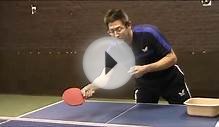
Tips to play Table Tennis
10 Quick Tips To Better Table Tennis
1. Know what spin is on the ball. The key to acquiring this important skill is to carefully watch the opponent’s racket when it makes contact with the ball. If the opponent’s racket is moving from low to high, the spin is topspin; from high to low, backspin; from his/her left to right, right sidespin; and from right to left, left sidespin.
2. Compensate for the spin with your racket angle. If topspin, angle your leading racket face down and contact the ball above its center; if backspin, angle the leading racket face up and contact the ball below its center; if right sidespin, angle the leading racket face to the right and contact the ball to the left of its mid-line; if left sidespin, angle the leading racket face to the left and contact the ball to the right of its mid-line. While holding the racket at the suggested angle, stroke gently forward. Only after you have developed a “feel” for the spin should you stroke the ball with more force.
3. Use your whole body when you stroke your forehand. Make sure that you rotate your hips and shoulders backwards during the backswing and then forward into the ball as you stroke your forehand. This motion is coordinated with a transfer of your body weight from the back foot to the front foot. The harder you hit your forehand, the more forceful your weight transfer must be. A common forehand mistake is to use only your arm to hit the ball, which severely limits your power and consistency.
4. Maintain a good ready position. A good ready position is balanced and prepares your body to move instantly in any direction. Use it when preparing to return serves and between strokes. The basic sequence of a rally is as follows: (A) put yourself in a good ready position, (B) move to the ball with your feet, staying balanced, (C) stroke the ball, (D) return to ready position, and (E) repeat B, C, and D until the rally ends.
5. Train your strokes until they are "automatic." When you first learn a new skill, you use a lot of mental energy to formulate a clear mental picture of how the stroke looks and feels. Once this mental picture is relatively accurate, you should then practice that skill repeatedly until you no longer have to think about how to do it. This is your “automatic stage”. Your best performance will come when you operate on “automatic” and you do not analyze your skill. You just “let it happen.”
6. Use only your own racket. It’s important to get your own racket and then to use it exclusively. Every racket has its own “feel” and playing characteristics, and you will benefit greatly by using only one racket so you’re not always trying to adapt to a different one. Also, take good care of your racket; treat it with respect. Keep it in a case when you’re not using it. If you’re using inverted sponge rubber (smooth surface), you should wash it with soap and water or a special racket cleaner after every use.
7. Develop sidespin serves. Few beginners use sidespin on their serves; whereas, top players use sidespin on almost every serve. Sidespin is almost always combined with either topspin or backspin; pure sidespin is extremely rare in table tennis. Particu larly useful is a sidespin/backspin serve that is low to the net and bounces twice on the other side of the table. This type of serve will severely limit your opponent’s serve return options.
8. Keep your returns low over the net. In general, the lower over the net you place your shots, the less angle your opponent can use and the harder it is for him/her to hit it with power. The one exception to this rule is if you use lobs, you will want to place the ball very high over the net (and as close to the end of the table as possible).
9. Practice more than you compete. By practicing, I mean all the time you spend developing your game by concentrating on some aspect you want to strengthen. The primary object during practice is to develop your game. On the other hand, when you compete, your main object should be to win, not to work on some part of your game. It is advisable to play practice games where the object is to blend in a new skill or tactic into a match-like situation before you compete. The emphasis for these practice games is still on development, not winning. And when you do compete, even though your main emphasis is on winning, you can still learn a lot about your game (development) if you analyze your matches after they are over.
10. Join a table tennis club. To really make progress with your game, it’s important to find others with similar desires and interact with these people. A table tennis club is the best place to do this. Most clubs have players of all different playing levels. Find someone of similar playing ability as yourself and make a commitment to each other to practice regularly. Periodically test your progress by competing with players of higher ability. Furthermore, most clubs have a coach who can help speed up your development. To find a club in your area, contact USA Table Tennis.
RELATED VIDEO


Share this Post
Related posts
British Table Tennis players
George Chester Barnes (born 27 January 1947) is a former English table tennis champion, who was England No. 1 player for…
Read MorePlaces to play Table Tennis Near me
Name Location Contact Person Contact Number Bradley University TTC Bradley University Haussler Hall Peoria, IL 61625 George…
Read More










